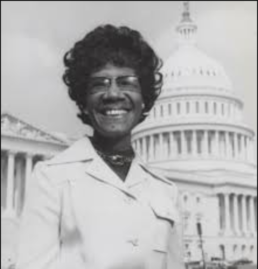These life stories may contain descriptions of childhood trauma and abuse, as well as images, voices and names of people now deceased. If you need help, you can find contact details for some relevant support services on our support page.
African American politician, Shirley Chisholm (1924-2005) was in kinship care as a child.
Shirley Anita St Hill Chisholm was born in Brooklyn, New York to recent migrants from Barbados, Charles Christopher St Hill (orphaned at age fourteen) and Ruby Seale. Shirley was the oldest of their four daughters.
Charles had a low-paying job and Ruby, a skilled seamstress, was compelled to work from home taking in sewing. Ruby found it difficult to manage three daughters and work. Therefore, in November 1929, Shirley and two of her sisters (the youngest was born after this) were taken by Ruby back to Barbados to live with their maternal grandmother.
Ruby stayed with her daughters for six months, helping them adjust to their new life. Then she returned to Brooklyn. She would not see her children for six years (Winslow, 10).
Granny Seale was not responsible for the daily care of the children because she worked long hours as a domestic servant. It was Ruby’s nineteen-year-old sister, Myrtle, who looked after the children.
The grandmother’s large house sat on a plot that provided the family’s food: sweet potatoes, yams, corn, tomatoes, and root vegetables. The waters around the island provided abundant seafood… The children were all expected to do chores on the farm, and these including [sic] feeding and caring for the chickens, turkeys, and ducks as well as goats, sheep, and cows that provided milk (Winslow, 10).
Ruby Seale believed that the education in Barbados was better than that in the public schools of Brooklyn. Shirley Chisholm later recalled the pride she took in being educated in black-run schools by black teachers.
The St Hill girls arrived back in Brooklyn in 1934 to cold, poverty and “hierarchies in the public schools, based on class, race, and gender – hierarchies she would encounter and struggle against the rest of her life” (Winslow,16).
Education was encouraged by Ruby, and Shirley graduated from high school in 1942 and went on to university at Brooklyn College. She became involved in student politics, joining the Harriet Tubman Society which was founded in 1941 and to which most African American students on campus belonged.
Shirley St Hill worked in early childhood education after graduating from university in 1946. She also became active in community politics, joining the Democratic Club and the National Association for the Advancement of Colored People (NAACP).
In 1968, Shirley Chisholm was elected to the US House of Representatives, making her the first African American woman in Congress.
Shirley Chisholm was on the fence about running for Congress when a woman came to her Brooklyn apartment. The visitor, a poor mother, said that she and her friends wanted Chisholm to run. “She gave me a dirty envelope containing $9.62 in nickels, dimes and quarters that they had raised and promised that if I ran they would sponsor fund-raising affairs every Friday night to help finance my campaign,” Chisholm told Ebony. After the woman left, Chisholm sat down, took off her glasses, and cried (U.S. House of Representatives).
In Congress, Chisholm became known for her stand against the Vietnam War and for championing equity. Four years later, Chisholm decided to nominate as a Democratic candidate for President, “charging that none of the other candidates represented the interests of blacks and the inner-city poor.” She received 10% of the votes at the Democratic National Convention.
Shirley Chisholm left Congress in 1983. In December 2018 the City of New York announced that a statue of Shirley Chisholm will be erected outside Prospect Park in Brooklyn.
“I want history to remember me… not as the first black woman to have made a bid for the presidency of The United States,” Chisholm said, “but as a black woman who lived in the 20th century and who dared to be herself. I want to be remembered as a catalyst for change in America” (Cottman et al).
A biopic of Shirley Chisholm has been produced by actor Regina King and her sister, Reina King. The film was written and direct by John Ridley and stars Regina King as Shirley Chisholm.
References:
“Chisholm, Shirley Anita 1924-2005.” History, Art & Archives. United States House of Representatives. https://history.house.gov/People/Detail/10918
Cottman, Michael, Gaines, Patrice, Bunn, Curtis, Charles, Nick & Keith Harriston, Keith. Say Their Names: How Black Lives Came to Matter in America.UK: Hachette, 2021.
Durkin, Eric “It’s about time’: Shirley Chisholm, first black congresswoman, will get a statue.” The Guardian, 5 December 2018. https://www.theguardian.com/us-news/2018/dec/05/its-about-time-shirley-chisholm-first-black-congresswoman-will-get-a-statue
Landers, Jackson. “Unbought and Unbossed:” When a Black Woman Ran for the White House.” Smithsonian Magazine, 2016. https://www.smithsonianmag.com/smithsonian-institution/unbought-and-unbossed-when-black-woman-ran-for-the-white-house-180958699/
Michals, Debra. “Shirley Chisholm (1924-2005).” National Women’s History Museum, 2015. https://www.womenshistory.org/education-resources/biographies/shirley-chisholm
“Whereas: Stories from the People’s House. Unbought and Unbossed.” History, Art & Archives. United States House of Representatives. https://history.house.gov/Blog/2018/March/3-5-photo-chisholm/
Winslow, Barbara. Shirley Chisholm: Catalyst for Change. Routledge, 2018.
Image available here.
